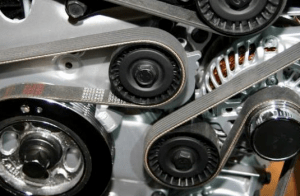
How Important is Your Vehicle’s Serpentine Belt?
Many vehicle owners are unaware of just how important the belts and hoses are to the longevity of the engine. Because they are constantly in use while your vehicle is running, they undergo a lot of wear and tear. Belts are responsible for powering parts like the water pump, power steering pump, air conditioning and more. In this blog post, we are going to talk about the serpentine belt – one long, winding belt that works to keep your alternator, power steering pump, air conditioner and water pump running. Lately, we have been fixing vehicles with broken belts or belts that have thrown off because of worn out idlers, tensioners, and seized water pumps. Here’s how it happens and what you can do about it.
The serpentine belts in today’s vehicles are built to last anywhere from 50,000 to 100,000 miles. That doesn’t mean you can ignore them and wait until something happens, like a broken belt, before you replace it. A serpentine belt should always be replaced according to the manufacturer’s recommendations, or earlier, if it is showing signs of excessive wear, like deep cracking in the ribs or a noisy belt. It can also fail if there is a problem with one of the parts the belt powers (e.g. water pump).
Wondering what happens if the belt breaks or slips? Everything from the alternator, power steering pump to the air conditioner and water pump stop working. That alone is very dangerous as you will lose power. Even worse, the cooling system won’t be able to circulate coolant to the engine to keep it from overheating. An overheated engine is at risk of some serious damage. That translates into a pretty expensive repair. All this can be avoided with proper maintenance.
With Proper Maintenance, You Can Minimize the Potential for a Broken Serpentine Belt
Proactive vehicle maintenance is beneficial in so many ways. You will have peace of mind knowing your vehicle is safe and reliable. You will also save money in the long run because you will not have to pay expensive repair bills. In the case of a serpentine belt that breaks and damages the engine, that could mean having to rebuild or replace the engine or worse – buying a new vehicle.
Here’s how to maintain the serpentine belt:
- Have the belts checked periodically. A serpentine belt that is aging may become shiny in appearance or look glazed. It may also show signs of cracks, hardening and loss of flexibility. Some belts may show excessive wear in the ribs and valleys. All of these things can lead to a belt slipping. Also, some belts are manually tensioned and need to be adjusted periodically. If we notice any of these signs while your vehicle is in for routine maintenance, we will let you know so you can replace it.
- Maintain the cooling system. Change the coolant before it can no longer protect the engine parts from overheating or corroding. Change belts and hoses when they show signs of wear. If your vehicle is running hot, or you find you have to add coolant on a regular basis, there is a leak in the system. Have it fixed.
Campus Auto Repair in Ft. Collins, Colorado, can assist you when it comes to the care of your vehicle. With each visit to our shop, we complete a courtesy inspection of your vehicle, including the serpentine belt and cooling system. If we find the coolant needs to be changed or any parts need to be replaced, we will let you know so you can have the work done before something breaks. If you are concerned about the condition of your vehicle’s serpentine belt or you need to have your cooling system serviced, give us a call or stop by the shop.
